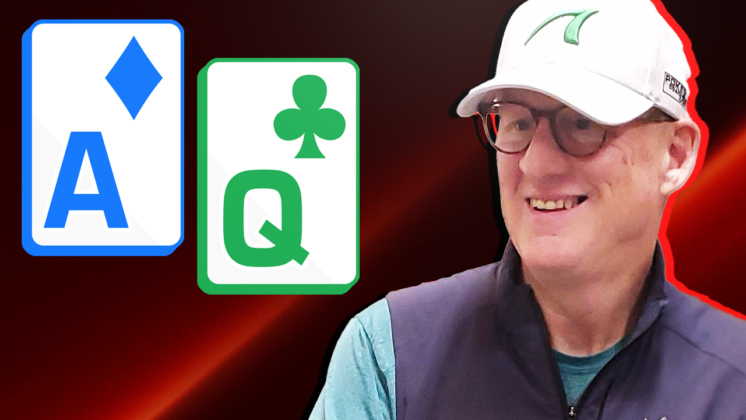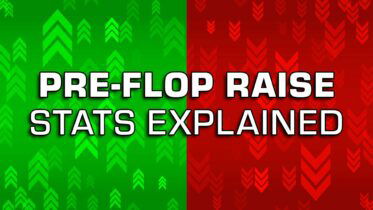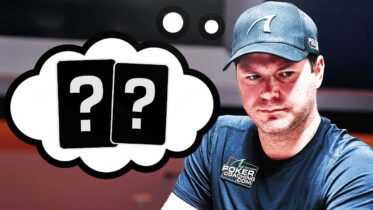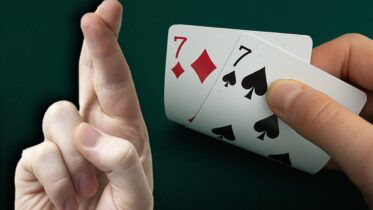Sometimes, it seems that the Universe is determined for me to find growth edges in my life. Day before yesterday was one of those.
First, playing ace-queen offsuit wrong
We had just gotten the afternoon $5/$10 no-limit hold’em game kicked off. Everybody was in a good mood because we had cards in the air almost a full hour before we usually do.
We were only in the second orbit when David opened to $40 in the cutoff. The button folded, and I found A♥Q♠ in the small blind. David is a very active gambly player, so I was happy to 3-bet, which I did, to $160. The big blind folded, and it was back on David, who chuckled.
“I’m all in.”
Oh man. We had both started with the maximum stack of $1,000. So I’d have to call $840 more. I had a bunch of thoughts:
“Ace-queen is everybody’s official second best hand.”
“Do I really wanna get stuck a stack before we’ve had our first dealer change?”
“Should I have gotten a scone at the bakery when I got my coffee?”
Maybe I really didn’t want to get stacked before the first dealer change. Maybe I didn’t want to compound the regret of not having a scone by not having any chips. Whatever, I folded.
David scowled.
“What, no gamble?”
Fair question. I shrugged and sipped my coffee. We all went back to playing poker.
Later, I sat out for a one-orbit break, took a brief walk in the fresh air, and consulted my phone. After David shoved his $1,000 into the middle, I would have to call $840. But there was already $330 in the pot before his shove (my $160, his $160, and $10 dead). So I was calling $840 to win $1170. How much equity did I need to make that call?
If the pot is $P, and the all-in bet you’re facing is $B, then you need B/(P+(2 x B)) equity to have a break-even call. So facing David’s $840 shove, I needed 840/(330 + (2 x 840)) = 41.8% equity.
With my calculator having done its job, I moved to PokerCruncher. David, he’s not afraid of a gamble. In fact, I might go so far as to say he’s a gamblephile. So when constructing a range for him, I had to add a few hands that I probably wouldn’t be shoving.
No matter how I tried to box David into a snug range, my best poker instincts wouldn’t let me narrow it too much. David’s scowl when I folded was legitimate – sure, maybe he had me drawing slim with QQ, but he would have been more than happy to flip his K♣J♣ against my hand.
Even against the narrowest range I could have honestly given David, I still had 42.7% equity – close, but definitely a call.
And it was possible that his actual range was much wider.
Bah. Not only did I not have a scone, but I had passed up a +EV opportunity because… because honestly I just didn’t feel like flipping for stacks when I was barely settled into my seat.
I was disappointed in myself.
But as you do, I went back to the game, centered myself, posted my big blind when it came around, and got back into the action.
Second time, think it through
A couple of hours passed, and things went distinctly my way. I flopped three sets, which is usually a harbinger of a good session, and in this case it was. I was up about a buy-in when the Universe decided it was going to give me another whack at this “ace-queen offsuit” thing.
A tilted player in early position opened to $40, and got a call from an even more tilted player in the hijack. I was on the button, and looked down at A♣Q♦. Well, here we go again.
I made it $160, and it folded back around to the opener. He promptly shoved for $900 total (I had him well covered). I was starting to think about what I was going to do, when the middle player shrugged, and pushed his $600-ish into the middle.
I thought back to my pot with David. Whatever I was going to do, I was going to think about it first. I would have to call $740 more, but now there was $160+$900+$600 = $1660 in the pot. I was getting a little better than 2:1 to call. If I were getting exactly 2:1, then I’d need 33% equity to have a breakeven call. I mentally waved my hands and thought, “Okay, I need 30% equity.”
Apparently, my mental hand-waving is accurate – I needed exactly 30.8% equity to break even on the call. Now, did I have 30% equity?
At the time, I was pretty sure that both players were sufficiently tilted that my A-Q offsuit was holding its own. That is, I wouldn’t have been surprised to see that it had at least 33% equity. But in the aftermath of the hand, it was a good excuse to run some actual numbers. I gave the opener this range:
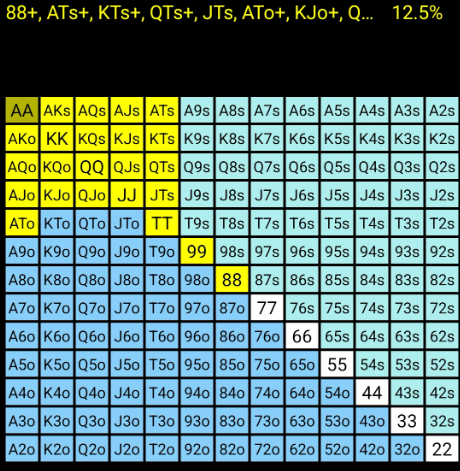
And I gave the “more tilted” player a 20% range that looked like this:
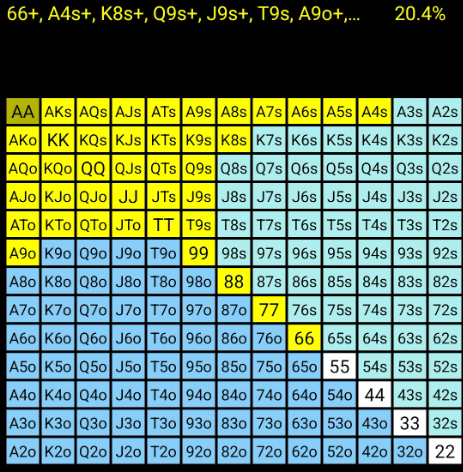
It turned out that, against those two ranges, I had over 36% equity. Much of that was from the contribution of the hitchhiker – the range I assigned to him had only 29% equity.
As an aside, I tried giving the original opener a snugger range:
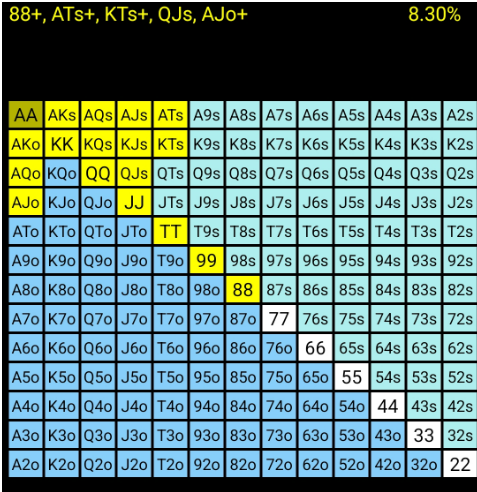
And learned that, even against that range, I had 32.2% equity, again, mostly due to the gift from the third player.
Sometimes, you just put the money in and see who wins
Obviously I didn’t do all this in the heat of the moment. But my gut told me that I had the right odds to call and see five cards. Interestingly, my gut also told me, “Hey, we’re up about a buy-in. We’ve got $160 invested in the pot, and you wanna throw another $740 in? That’s risking our entire profit.”
My brain said to my gut, “Yep. You already told us that you think their ranges are wide. If so, we’re in +EV shape, so we put the money in, and somebody’s going to win a big pot.”
I announced that I was calling, and slid some chips toward the middle.
The all-in player had already been showing his cards to his neighbors, saying “Hold, hold.” Maybe I should have taken that as a hint, because he turned over pocket kings. Well, that was definitely in the range I gave him, so fine.
The other player didn’t show his cards.
The board ran out: 4♠-5♣-9♦-3♥…
“Deuce?” I thought.
A♥.
That’ll do.
The fellow with the kings sighed, and left the table. The other player simply mucked his cards. The dealer pushed a mountain of chips to me.
The decision is the only thing that matters
It’s important to understand that even if the river had been the 9♠, dusting off the profit I’d worked so hard to build up, the call was correct. And even if whatever two cards David had in the first hand would have beaten my AQ, folding there was still a mistake.
I’m happy that I got a second bite at the A-Q offsuit apple, and made the right decision that time. Of course, having all those chips pushed to me felt good, but that was the icing on the cake.
On my second dance with ace-queen offsuit, I stopped, worked the problem through, and made a good decision. That’s the cake.
